 |
 |
 |
| |
Addition of extended zidovudine to extended nevirapine prophylaxis reduces resistance in infants who were HIV-infected in utero:
the PEPI- Malawi Study
|
| |
| |
Addition of extended zidovudine to extended nevirapine prophylaxis reduces resistance in infants who were HIV-infected in utero: the PEPI- Malawi Study
Reported by Jules Levin
18th Intl HIV Drug Resistance Workshop, June 9-12 2009, Ft Myers Florida
J Lidstrom1, N Kumwenda2, DR Hoover3, G Kafulafula4, Q Li2, LM Mofenson5, MG Fowler1,6, MC Thigpen6, TE Taha2 and SH Eshleman1
1Johns Hopkins University School of Medicine, Baltimore, MD, USA
2Johns Hopkins University Bloomberg School of Public Health,
Baltimore, MD, USA
3Rutgers University, Piscataway, NJ, USA
4University of Malawi, Blantyre, Malawi
5National Institutes of Health, Rockville, MD, USA
6Centers for Disease Control and Prevention (CDC), Atlanta, GA, USA
from Jules: years ago the NIH justified providing NVP single dose for preventing MTCT in the face of causing NVP resistance by saying if you waited 6 months after stopping NVP for PMTCT then NVP resistance would NOT emerge after initiating NVP-based HAART, despite the objections of leading resistance researchers and I expressed my disbelief as well to the NIH. But the NIH insisted they were right, but it is now my understanding it is pretty clear they were wrong. Another instance where the politics of HIV hurts patients. The gatekeepers of research in HIV often put their personal and political agenda ahead of patient needs. Another example is the dismissal of the immediate need to conduct specific aging research into HIV-caused senesence and trying to develop an intervention. Because it is pretty clear HIV causes senesence, early aging of the T-cell repertoire seen normally only in elderly people. But once a patient gets HIV-infected this same T-cell repertoire change occurs in HIV+ individuals soon after infection. This likely contributes to early frailty in HIV+s. Data from the MACS found HIV+ individuals were at up to 15 times greater risk for frailty compared to HIV-negatives. Frailty is another measure of being elderly. The study found HIV+ individuals at 55 yrs old had more or similar frailty than 65 yr old HIV-neg individuals. But our research community has yet to prioritize this concern.
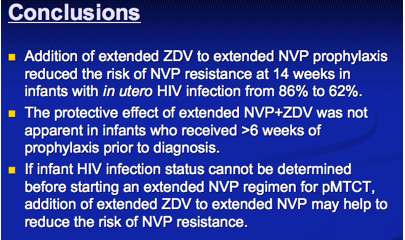
ABSTRACT
INTRODUCTION: Extended nevirapine (NVP) prophylaxis reduces the risk of post-natal HIV transmission, but may induce resistance among infants who are HIV-infected in utero. An infant's HIV infection status is often not known when prophylaxis is initiated at birth. We compared NVP resistance in infants who were subsequently found to have been HIV-infected in utero, but who were exposed before HIV diagnosis to either extended NVP prophylaxis or extended NVP plus zidovudine (ZDV) prophylaxis in the PEPI-Malawi Study. In the PEPI-Malawi Study, there was no difference in efficacy of extended NVP+ZDV versus extended NVP for prevention of post-natal HIV infection.
METHODS: In PEPI-Malawi, most HIV-infected women received single-dose NVP (sdNVP) prior to delivery. Infants were randomized at birth to receive: sdNVP plus 1 week of ZDV (control), control plus extended NVP prophylaxis
(daily to age 14 weeks) or control plus extended NVP+ZDV prophylaxis (daily to age 14 weeks). Prophylaxis was stopped when infant HIV infection was confirmed. Plasma collected at 14 weeks was available from 105 of 161 infants in the extended study arms who were HIV-infected in utero (positive HIV DNA test at birth). HIV genotyping was performed using the ViroSeq HIV Genotyping System.
RESULTS: Genotyping results were obtained for 88 (83.8%) of 105 14-week samples. Among the 88 infants with genotyping results, prophylaxis was stopped at a median of 6 weeks of age in both study arms (range 1-14 weeks). At 14 weeks of age, the proportion of infants with NVP resistance was lower in the extended NVP+ZDV arm than the extended NVP arm (28/45 [62.2%] versus 37/43 [86.0%]; P=0.015); none of the infants had ZDV resistance. Addition of extended ZDV to extended NVP reduced the risk of NVP resistance in infants whose prophylaxis was stopped by 6 weeks (19/35 [54.3%] versus 30/35
[85.7%]; P=0.008), but not in infants whose prophylaxis was continued beyond 6 weeks (9/10 [90.0%] versus 7/8 [87.5%]; P=0.71).
CONCLUSIONS: Addition of extended ZDV to extended NVP prophylaxis significantly reduced the risk of NVP resistance at 14 weeks in infants with in utero HIV infection, provided that HIV infection was diagnosed and the prophylaxis was stopped by 6 weeks of age.

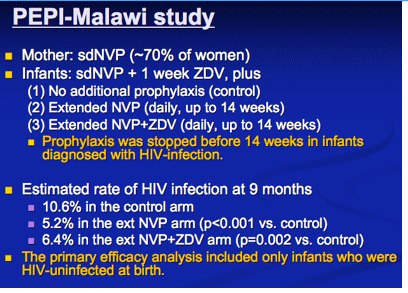
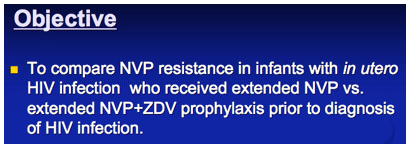
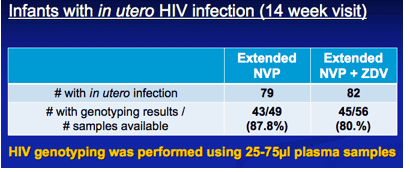
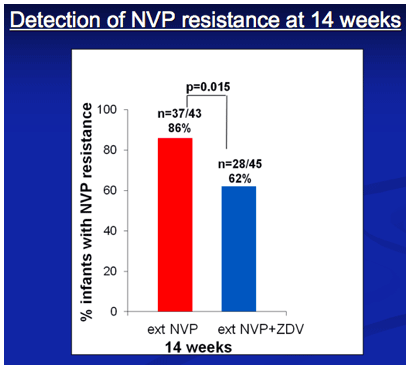
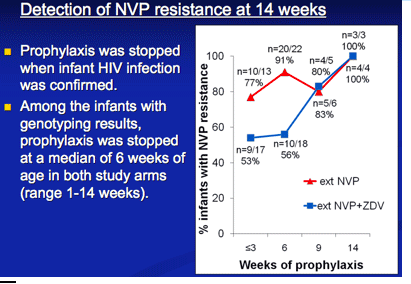
|
| |
|
 |
 |
|
|